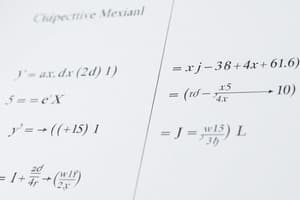Podcast
Questions and Answers
What concept in calculus gives us the rate of change of a function?
What concept in calculus gives us the rate of change of a function?
- Quotient rules
- Power rules
- Derivatives (correct)
- Integrals
If f(x) = x², what is the derivative of f with respect to x?
If f(x) = x², what is the derivative of f with respect to x?
- df/dx = x
- df/dx = 2
- df/dx = 2x (correct)
- df/dx = 1
What does integral calculus focus on?
What does integral calculus focus on?
- Finding the area under a curve (correct)
- Power rules
- Differentiation rules
- Determining rate of change
Which rule is used to calculate the derivative of a function?
Which rule is used to calculate the derivative of a function?
What does the integral of a function from a to b represent?
What does the integral of a function from a to b represent?
What is one of the applications of calculus mentioned in the text?
What is one of the applications of calculus mentioned in the text?
How can calculus be used in solving optimization problems?
How can calculus be used in solving optimization problems?
What aspect of functions do derivatives and integrals provide insights into?
What aspect of functions do derivatives and integrals provide insights into?
In what fields can calculus find applications, as mentioned in the text?
In what fields can calculus find applications, as mentioned in the text?
Which mathematical concepts are essential for understanding the behavior of functions according to the text?
Which mathematical concepts are essential for understanding the behavior of functions according to the text?
Study Notes
Introduction
Calculus is a branch of mathematics that deals with the study of continuous change. There are two primary concepts in calculus: derivatives and integrals. Derivatives give us the rate of change of a function, while integrals give us the area under the curve. In this article, we will focus on the topic of calculus, specifically the study of derivatives and integrals.
Derivatives
A derivative is a measure of the rate of change of a function. For example, if we have a function f(x) = x², the derivative of f is df/dx = 2x. This tells us that the function is changing at a rate of 2 times the input value. The derivative of a function can be calculated using various methods, including power rules, quotient rules, and the chain rule.
Integrals
An integral is a measure of the accumulation of a function over a specified interval. In other words, it represents the total area under the curve of a function. For example, if we have a function f(x) = sin(x), the integral of f from a to b is ∫ sin(x) dx from a to b. This calculates the area under the curve of f(x) = sin(x) from x = a to x = b.
Integral Calculus vs. Derivative Calculus
Integral calculus and derivative calculus are two aspects of calculus that focus on different aspects of a function. Integral calculus is used to find the area under a curve, while derivative calculus is used to determine the rate at which a function changes. Both concepts are essential for understanding the behavior of functions and their relationships with other mathematical concepts.
Applications of Calculus
Calculus has numerous applications in various fields, including physics, engineering, economics, and computer science. Real-world problems often require the use of derivatives or integrals to solve them effectively. For example, calculus can be used to:
- Find maximum or minimum points in a given set of data.
- Determine the velocity and acceleration of an object moving along a path.
- Solve optimization problems, such as minimizing cost or maximizing profit.
- Analyze traffic flow patterns to optimize transportation routes.
- Study population dynamics and predict future trends.
- Develop complex financial models and analyze risk.
- Model physical phenomena, such as fluid flow, heat transfer, and electromagnetic fields.
- Perform numerical analysis, such as solving differential equations and approximating functions.
- Investigate geometric properties and shapes, like the surface area of curved objects.
In conclusion, calculus plays a vital role in our understanding of continuous change and its impact on various domains of knowledge. By studying derivatives and integrals, we gain insights into the dynamic nature of functions and develop powerful tools for solving real- world problems.
Studying That Suits You
Use AI to generate personalized quizzes and flashcards to suit your learning preferences.
Description
Explore the fundamentals of calculus, focusing on derivatives and integrals. Learn how derivatives give the rate of change of a function and how integrals calculate the area under the curve. Discover the applications of calculus in various fields such as physics, engineering, and economics.




